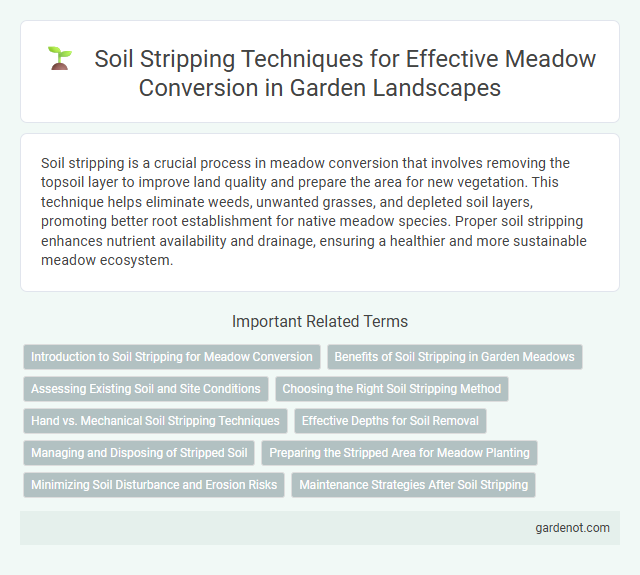Soil stripping is a crucial process in meadow conversion that involves removing the topsoil layer to improve land quality and prepare the area for new vegetation. This technique helps eliminate weeds, unwanted grasses, and depleted soil layers, promoting better root establishment for native meadow species. Proper soil stripping enhances nutrient availability and drainage, ensuring a healthier and more sustainable meadow ecosystem.
Introduction to Soil Stripping for Meadow Conversion
Soil stripping is a critical initial step in meadow conversion, involving the removal of nutrient-rich topsoil to reduce soil fertility and encourage native wildflower growth. This process typically targets the upper 10-15 cm of soil, where organic matter and seed banks are concentrated, effectively resetting the soil profile for biodiversity enhancement. Proper soil stripping methods help suppress aggressive grasses and invasive species, promoting successful establishment of diverse meadow ecosystems.
Benefits of Soil Stripping in Garden Meadows
Soil stripping in garden meadows enhances nutrient management by removing nutrient-depleted topsoil, promoting healthier plant growth and increased biodiversity. This process improves soil structure and aeration, facilitating water infiltration and root development essential for meadow vitality. By controlling invasive species and reducing weed dominance, soil stripping supports the establishment of native grasses and wildflowers, creating a balanced and sustainable meadow ecosystem.
Assessing Existing Soil and Site Conditions
Assessing existing soil and site conditions is crucial for effective meadow conversion, involving detailed analysis of soil texture, pH levels, nutrient content, and moisture availability to determine site suitability. Conducting soil tests, including sampling and laboratory analysis, helps identify compaction issues, organic matter content, and potential contaminants that may affect plant growth. Evaluating topography, drainage patterns, and existing vegetation provides insights into microclimate influences and guides soil stripping depth and techniques for optimal meadow establishment.
Choosing the Right Soil Stripping Method
Selecting the appropriate soil stripping method is crucial for successful meadow conversion, as it directly impacts soil health and vegetation restoration. Techniques such as topsoil removal, sod stripping, or turf harvesting must be evaluated based on soil type, moisture content, and the intended ecological outcomes. Proper method selection enhances nutrient retention, minimizes soil erosion, and supports native plant establishment in meadow ecosystems.
Hand vs. Mechanical Soil Stripping Techniques
Hand soil stripping offers precise control for meadow conversion projects, minimizing root disturbance and preserving native seed banks, vital for maintaining biodiversity. Mechanical soil stripping accelerates large-scale meadow restoration, enabling rapid removal of topsoil layers but risks compacting soil and damaging delicate ecosystems if not carefully managed. Selecting appropriate techniques depends on project scale, environmental sensitivity, and restoration goals to balance efficiency with ecological impact.
Effective Depths for Soil Removal
Effective depths for soil removal during meadow conversion typically range from 15 to 30 centimeters, optimizing the elimination of nutrient-rich topsoil to encourage native species growth. Precise soil stripping depth varies based on initial soil fertility and vegetation type, ensuring minimal disturbance to subsoil structure while reducing excessive nutrient loads. This depth control promotes successful meadow establishment by balancing nutrient removal and soil stability, crucial for maintaining biodiversity and ecosystem functions.
Managing and Disposing of Stripped Soil
Effective management and disposal of stripped soil during meadow conversion are crucial to maintaining soil health and preventing environmental degradation. Stripped soil should be stored in designated areas with proper drainage to minimize erosion and nutrient loss, while nutrient-rich topsoil can be reused to enhance soil fertility in restoration zones. Implementing best practices such as layering soil horizons separately and avoiding compaction preserves soil structure and promotes successful vegetation establishment in converted meadows.
Preparing the Stripped Area for Meadow Planting
After soil stripping, the prepared area must be leveled and cleared of debris to create an optimal seedbed for meadow planting. Incorporating organic matter into the exposed soil enhances nutrient availability and moisture retention, promoting vigorous germination and root development. Proper soil preparation ensures improved water infiltration and encourages diverse native meadow species establishment.
Minimizing Soil Disturbance and Erosion Risks
Soil stripping in meadow conversion aims to minimize soil disturbance by carefully removing only the top vegetative layer, preserving the underlying structure and nutrients essential for ecosystem recovery. Techniques such as low-impact machinery and phased stripping reduce erosion risks by maintaining soil integrity and preventing runoff. Implementing buffer zones and immediate revegetation further stabilizes the soil, enhancing long-term meadow restoration success.
Maintenance Strategies After Soil Stripping
Regular monitoring of soil moisture and nutrient levels is essential for effective maintenance after soil stripping during meadow conversion. Implementing targeted fertilization and erosion control measures helps restore soil structure and supports native plant establishment. Periodic reseeding with native grass species ensures long-term soil stability and biodiversity enhancement.
Soil stripping Infographic

 gardenot.com
gardenot.com